Living Fence: 25 Ideas for Natural Living Fences and Living Walls (Pictures)
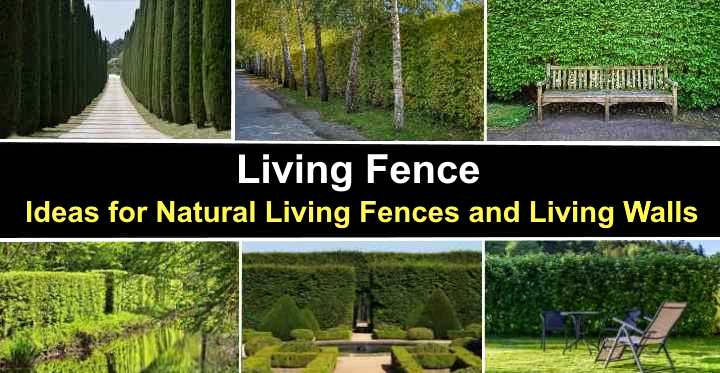
A living fence is a great way to grow a natural privacy screen, hedge, or windbreak in your front or backyard. In most cases, planting and growing a living fence is less maintenance and more cost-effective than installing wooden or chain-link fences. Evergreen bushy trees and shrubs are ideal plants for creating a beautiful living wall to complement your garden landscape.
There are more benefits to growing a living fence than just adding greenery to your garden. Creating a natural privacy wall with bushy shrubs improves soil structure, enhances biodiversity, and is more attractive than wooden or chain-link fences. Living fences can also last longer than constructed fences and are more environmentally friendly.
This article is a guide to the best shrubs and trees for growing a living fence. Descriptions and pictures of hedging plants will help you choose the best variety of evergreen trees or shrubs for planting in your garden.
What Is a Living Fence?
A living fence is typically a row of bushy shrubs or trees growing close together. The deciduous or evergreen foliage grows to create a dense green natural screen. Living fences are attractive and practical solutions to separate boundaries, increase security, provide shelter, or enhance a garden’s aesthetics.
The Benefits of Living Fence
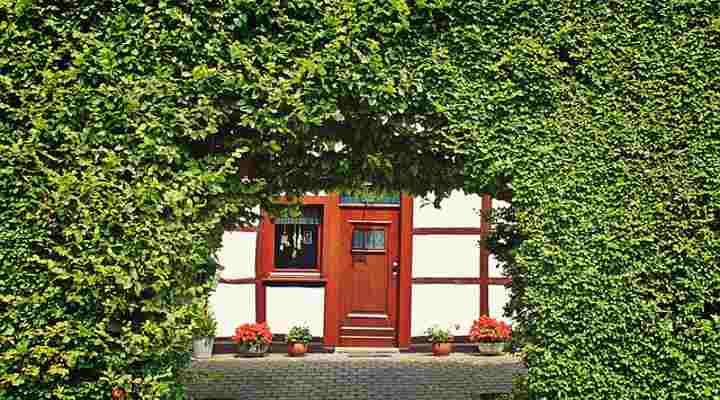
One of the main advantages of natural living fence is enhancing your garden landscape
Living fences have all the functions of a brick wall or wooden fence, only more appealing. Once established, there is little maintenance to care for a natural screen, apart from light annual pruning.
Here are some more benefits of a natural living fence:
A living fence is cost-effective. Planting hedging plants is cheaper than buying fence panels, bricks, or fence posts. Additionally, living walls are typically more robust than wooden or chain-link fences.
Another benefit of natural green fences is that they are low maintenance. Living fences can also last longer than constructed fencing. And, you never need to paint them to keep the evergreen barrier looking beautiful.
Using trees and shrubs to create a natural living wall supports biodiversity and enhances the soil structure. Hedgerows become shelter and food for many beneficial insects, animals, and birds.
A living privacy fence can act as a windbreak. Planting tall evergreen conifers tightly together creates a tall, sturdy privacy screen. Depending on the variety of privacy trees, the natural windbreak can be many feet tall.
Growing a tall living fence has benefits if planning restrictions restrict the height of constructed walls or wooden fences. Usually, there are no limits to the size privacy trees can grow.
The Disadvantages of a Living Fence
Living fences may not be ideal for all gardens. And, if you’re looking for a maintenance-free yard, then the added care needed to look after a natural screen is something to consider.
The main issue with growing a living fence is what happens if the plant dies. If a hedging shrub in the fence gets a disease, you’ll have a gaping hole in your screen. Also, it takes several years for hedge plants to grow to the required height.
Before planting a natural fence, it’s vital to carefully select the best type of shrub or tree for your needs. Many suitable hedge plants are fast-growing and don’t take much care to maintain.
Ideas for Creating Living Walls

Evergreen trees can create a tall dense living fence that is suitable especially for larger garden landscapes
When planning a living fence, you typically have two options—to choose shrubs or trees. The idea of planting a natural living wall is to create dense foliage at the height you require in your garden landscape.
Shrubs create ideal living walls if you have a small yard. Bushy shrubs typically grow between 3 and 6 ft. (1 – 1.8 m) tall. So, if you need to landscape a small garden, many evergreen shrubs are perfect for creating a living wall that stays green all year long.
When choosing appropriate shrubs for your living fence, consider the light requirements, USDA growing zone, and watering needs.
Another idea for a living fence is to plant tall evergreen trees. Especially in larger garden landscapes, tall hedge trees can create a natural windbreak. You can also grow conifers for a short, evergreen privacy screen. However, you will need to prune them regularly to control their height.
Living Fence: The Best Trees For Growing a Natural Living Fence
Let’s look at detailed descriptions and pictures of trees that are suitable for growing a living fence.
Arborvitae (Thuja) Trees for Privacy Living Fences
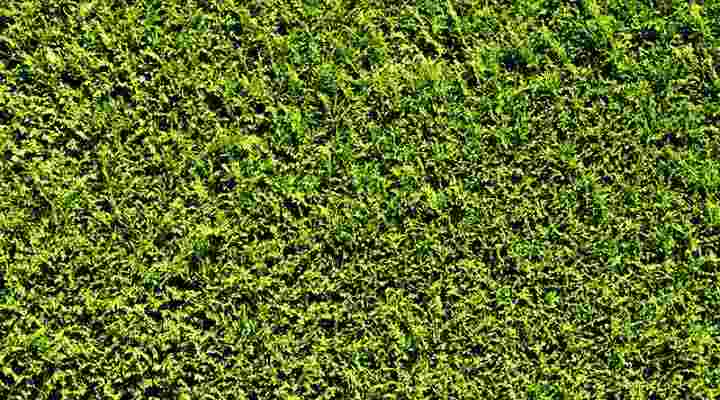
Arborvitae (Thuja) species are very popular as living fences and hedges with many cultivars to choose from
Arborvitae is a genus of coniferous, fast-growing evergreen trees and shrubs that make ideal living privacy fences. Their dense, soft, bright green feathery foliage makes excellent privacy screens, windbreaks, and natural barriers. The two most popular species for living fences are American arborvitae (Thuja occidentalis) and Giant arborvitae (Thuja plicata).
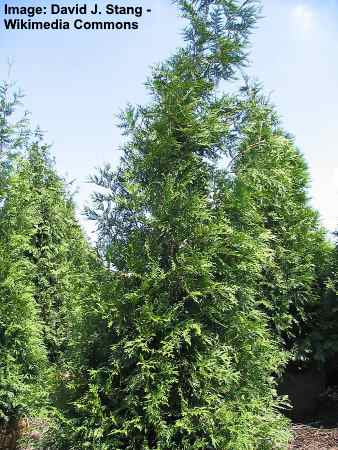
For fast growing living privacy fence choose arborvitae evergreen trees such as the Thuja ‘Green Giant’
Arborvitae grows best in full sun and well-drained soil. Planting the evergreen trees together in rows creates shrub borders, privacy hedges, screens, and living walls. Another advantage of arborvitae living fences is their cold hardiness. You can grow them in USDA zones 2 through 7.
Here a few of the best arborvitae species to plant as a natural privacy fence:
American arborvitae (Thuja occidentalis)—A fast-growing landscaping plant with dark green, soft, scale-like needle leaves. American arborvitae grows between 20 and 40 ft. (2 – 12 m) tall, so it’s more suited as a windbreak in large-yard landscaping. The columnar tree has a natural pyramidal shape and only requires pruning to maintain its height.

The columnar tall Thuja occidentalis is a popular tree for a living fence or privacy screen
Arborvitae ‘Emerald Green’ (Thuja occidentalis ‘Smaragd’)—This hedging tree is a dwarf evergreen tree ideal for growing as a hedge in small or large gardens. The ‘Smaragd’ evergreen arborvitae cultivar is a slow-growing conifer that grows between 12 and 14 ft. (3.6 – 4.2 m) tall. The conifer is identified by its compact, upright growth and sprays of bright-green glossy foliage.
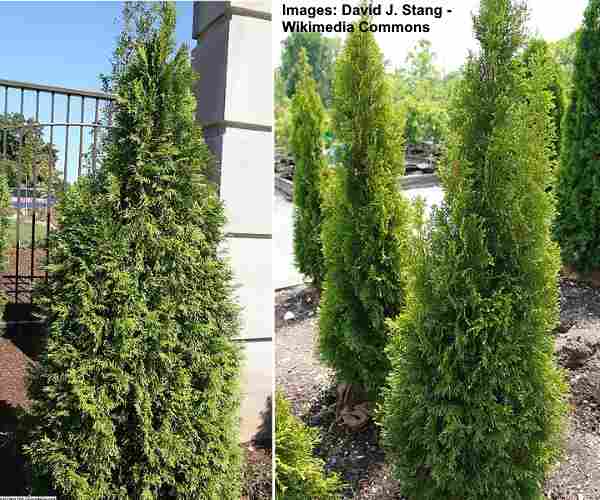
Pictures of thuja ’emerald green’ tree (‘Smaragd’) – it’s considered as one of the best trees for privacy
Baby giant arborvitae tree (Thuja plicata x standishii ‘Virginian’)—The dwarf arborvitae ‘Virginian’ is a cultivar of the popular ‘Green Giant’ arborvitae and is a fast-growing evergreen tree with a conical shape. Due to its short growth of up to 15 ft. (4.5 m) and dense foliage, it’s perfect as a living fence in most sizes of yards.
Leyland Cypress (Cupressus x leylandii)
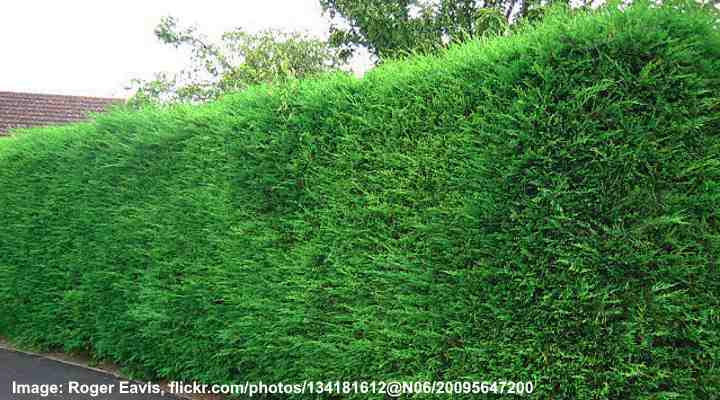
Leyland cypress is a popular hedging tree for a living fence – it’s a fast growing, dense evergreen tree hence it’s very commonly used as a privacy screen
The Leyland cypress is an evergreen conifer with soft, dense foliage that gives privacy and shelter throughout the year. Planting Leyland cypress trees in rows is perfect for growing a natural windbreak. As a tall conifer, the Leyland cypress grows up to 50 ft. (15 m) tall unless you prune it regularly.
You can plant a Leyland cypress living fence in USDA zones 6 through 10. Most people grow this popular hedging tree and keep it trimmed at 10 to 15 ft. (3 – 4.4 m) tall.
Hicks Yew (Taxus x media ‘Hicksii’)
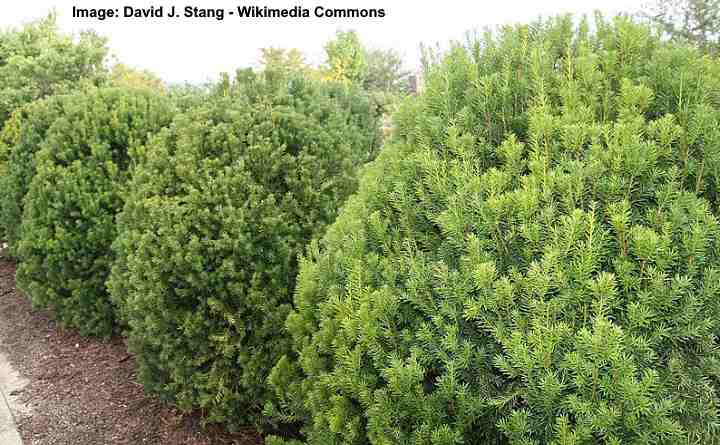
You can prune Hicks yew to create a decorative living fence for privacy from neighbors
Hicks yew is an evergreen bushy tree that creates a lush, dense living fence. Its relatively compact growth means that this slow-growing conifer is suitable for smaller to medium garden landscapes. The yew trees have a narrow, columnar shape that gradually spreads as they age. Hicks yew is ideal for formal hedges, foundation plantings, and privacy screens.
A Hicks yew grows between 12 and 20 ft. (3.6 – 6 m) tall and thrives in USDA zones 4 to 7. It’s easy to prune a Hicks yew hedge to create a box hedge shape. This popular landscaping tree is excellent for using as a hedgerow or topiary.
Spartan Juniper (Juniperus chinensis ‘Spartan’)
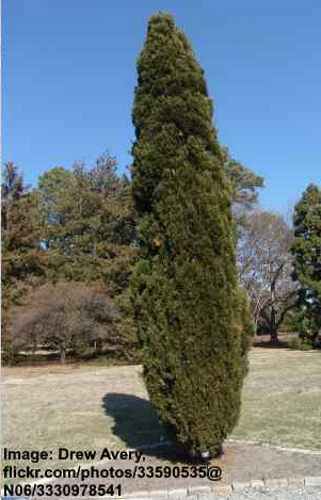
The evergreen Spartan juniper is a popular tree used for privacy living fence
The juniper cultivar ‘Spartan’ is an elegant, fast-growing, bushy columnar evergreen with fastigiated, spreading growth. The ‘Spartan’ juniper is an excellent choice as a formal hedge plant. The dark green, soft needle-like leaves form a dense screen for privacy and protection.
‘Spartan’ juniper cultivars perform best in full sun and well-draining soil in USDA zones 4 to 9. It grows between 15 and 20 ft. (4.5 – 6 m) tall. The juniper cultivar’s spreading growth means that it forms a beautiful hedge or natural windbreak.
Brodie Eastern Red Cedar (Juniperus virginiana ‘Brodie’)

The ‘Brodie’ cedar is a drought-tolerant tall tree commonly used as a privacy hedge or living fence for screening neighbors out
The ‘Brodie’ is a species of false cedar with bright green, dense foliage that forms a natural living fence. The soft scale-like ornamental leaves remain green throughout winter. As a low-maintenance hedging tree, the ‘Brodie’ eastern red cedar only requires light pruning to create a formal living fence or a large-scale privacy screen.
Brodie Eastern Red Cedar grows between 15 and 20 ft. (4.5 – 6 m) tall and 7 ft. (2 m) wide. Plant in full sun in USDA zones 3 to 8 to form an evergreen border hedge.
Moonglow Juniper Hedging Tree (Juniperus scopulorum ‘Moonglow’)
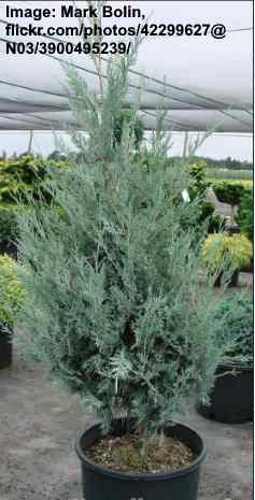
Planting moonglow juniper hedge trees creates an ornamental silvery-blue living fence
Like many juniper trees, the ‘Moonglow’ cultivar is a columnar tree with soft, feathery foliage. The attractive feature of the ‘Moonglow’ juniper tree is its dazzling silvery-blue leaves. Its dense growth habit forms a protective living fence when the trees are grown close together. Due to its height, the ‘Moonglow’ juniper tree also makes an ideal windbreak.
‘Moonglow’ juniper trees perform best in full sun in USDA zones 3 through 7. It grows between 15 and 20 ft. (4.5 – 6 m) and up to 6 ft. (1.8 m) wide. Grow the ‘Moonglow’ juniper if you want a spectacular silvery living fence for privacy, shelter, or noise protection.
Canadian Hemlock (Tsuga canadensis)
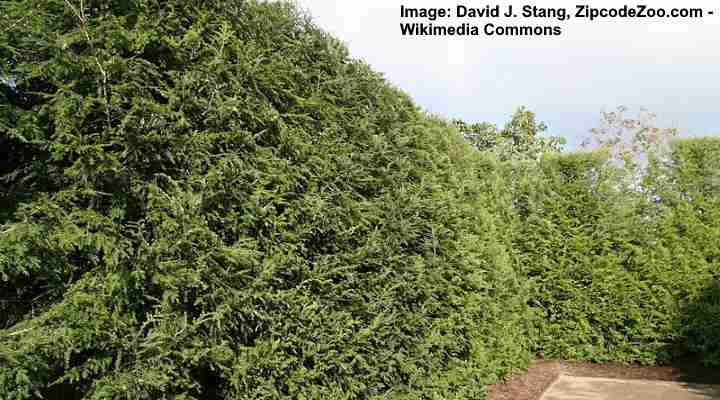
Canadian hemlock creates fast growing dense living fence for larger yards
The Canadian hemlock is a large coniferous tree that is suitable for growing as a tall privacy living fence. The evergreen foliage consists of flat sprays that have short green needle-like leaves. The hemlock species has a conical shape and spreading, arching branches. Growing in a row, the Canadian hemlock is an ideal living fence, screen, or hedge.
This hemlock tree also goes by the name eastern hemlock. The tall hedge tree grows between 40 and 70 ft. (12 – 21 m) tall and up to 35 ft. (10 m) wide. The cone-producing tree thrives in partial to full shade in USDA zones 3 to 7.
Shrubs for Living Privacy Fence
Let’s look at detailed descriptions and pictures of shrubs that are suitable for growing a living fence.
Photinia ‘Red Robin’ (Photinia x fraseri ‘Red Robin’)
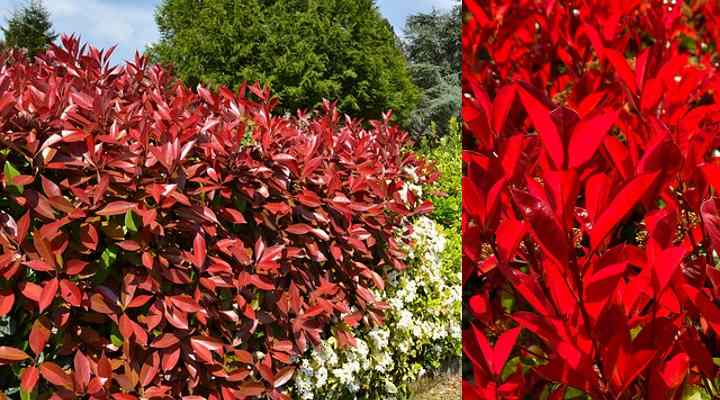
Grow Photinia ‘Red Robin’ living privacy fence for its beautiful red foliage
Also called Fraser photinia, this broadleaf, evergreen shrub with its bushy growth is ideal for a medium-sized living fence. The cultivar name comes from the bright red new leaves that appear in spring. The hedging shrub has shiny, leathery, dark green oval leaves, and it produces 5-petaled white flowers in late April.
The ‘Red Robin’ photinia shrub is a compact shrub, ideal for privacy screens, natural, informal borders, and hedgerows. You can grow a colorful photinia living fence in USDA zones 7 through 9, in full sun and loamy, well-drained soil. The hedging shrub matures at 9 to 12 ft. (2.7 – 3.6 m) tall.
Cherry Laurel (Prunus laurocerasus)
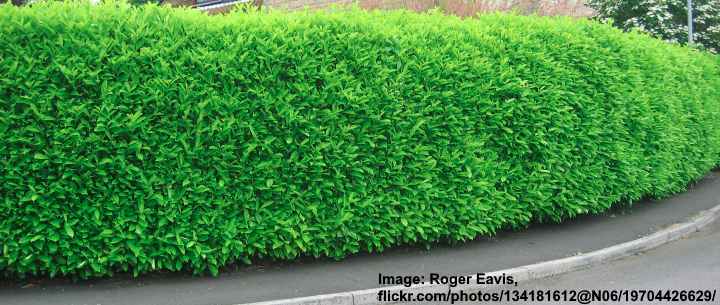
Cherry laurel is a great fast growing evergreen shrub used as a privacy hedge and as a living fence plant
The cherry laurel shrub is an excellent choice if you want a living fence that provides year-long privacy. The outstanding feature of the cherry laurel shrub is the shiny green foliage that has dense, wide-spreading growth. Another reason cherry laurel is a popular living fence shrub is its showy, fragrant white spring flowers.
Also called English laurel, this ornamental evergreen hedging shrub thrives in USDA zones 6 through 8. Although the privacy fence performs best in full sun, it adapts well to heavy shade. It grows 10 to 20 ft. (3 – 6 m) tall and 10 ft. (3 m) wide.
Cherry laurel is worth considering as a green living fence if you have a shade garden and need to create a natural border or protective screen.
Boxwood Hedge Plant (Buxus sempervirens)

Box hedging is a popular border shrub in formal gardens because it’s easy to shape and prune into natural living fence
Boxwood shrubs are some of the most popular plants for growing a living fence. The evergreen foliage consists of small shiny oval leaves and densely growing branches. You can plant boxwood living fences for small border hedgerows or large privacy screens.
The common name of Buxus plants comes from the fact that they are easy to prune and shape. You can create a formal living fence in a box shape or prune the shrubby plants into other shapes.
Here are some examples of boxwood shrubs that are suitable as a living fence:
Japanese boxwood ‘Green Beauty’ (Buxus microphylla var. japonica)—The ‘Green Beauty’ hedging shrub has lush, dense foliage and rounded growth habit. Thriving in USDA zones 6 to 9 and partial shade, the plant grows up to 5 ft. (1.5 m) tall. It’s ideal as a low-growing hedge, formal green fence, or natural security screen.

Buxus microphylla var. japonica is a good choice for a low living fence or for compact gardens
Boxwood Dee Runk (Buxus sempervirens ‘Dee Runk’)—Growing between 7 and 8 ft. (2 – 2.4 m) tall, this tall boxwood cultivar provides all-year privacy growing as a living fence.
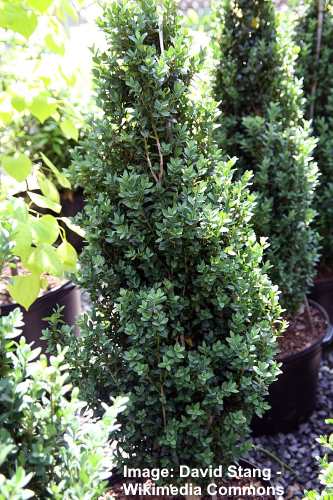
The elegant columnar growth of boxwood Dee Runk creates naturally attractive living fence
Boxwood ‘Winter Gem’ (Buxus microphylla ‘Winter Gem’)—The ‘Winter Gem’ boxwood cultivar is ideal for planting as a medium-sized living privacy screen. The densely growing shrub has a rounded growth and matures around 4 ft. (1.2 m) tall. This small shrub is ideal for creating hedging and natural screens in formal gardens or front or backyards. USDA zone 5-9.
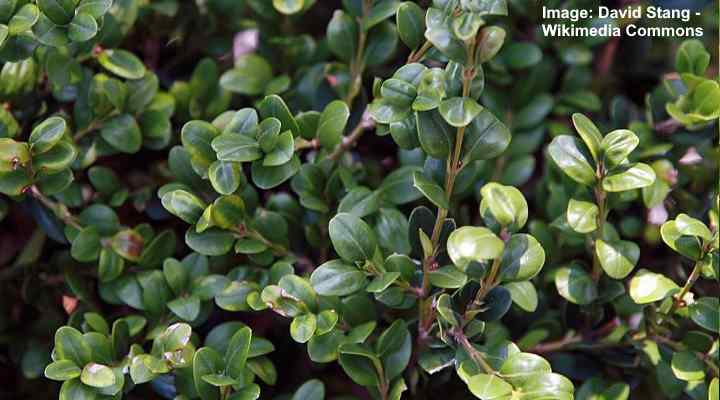
Planting Buxus Winter Gem is a great idea for a hardy low-maintenance living fence
Related reading: The best shrubs for foundation planting.
Holly Bushes for Living Privacy Fence (Ilex)
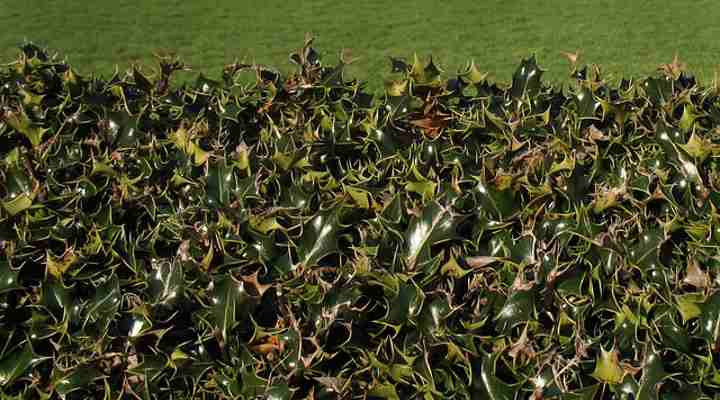
Holly bushes are common low-maintenance choice if you want evergreen living fence in your front or back yard
Holly bushes make ideal security screens or privacy hedges due to their dense growth and spiky foliage. The thorny, evergreen shrubs with their shiny leaves create beautiful, low-maintenance hedgerows.
Here are a few examples of holly bushes that are suitable for growing as living fences:
Alaska Holly (Ilex aquifolium ‘Alaska’)—The prickly leaves on the ‘Alaska’ holly help keep unwanted intruders out of your yard. The bushy shrub has narrow growth and grows 16 ft. (5 m) tall. Suitable for USDA zones 5 to 9.
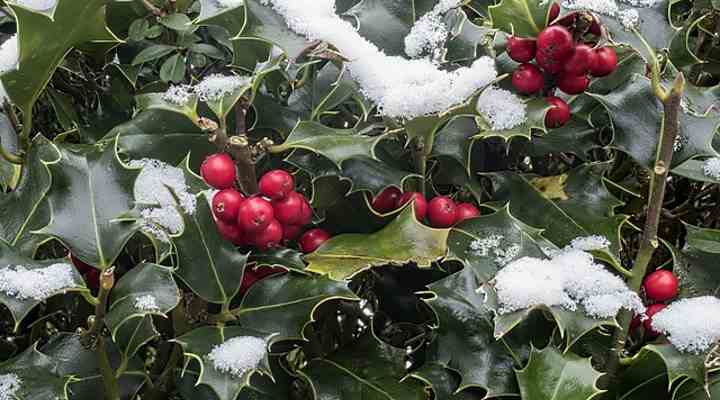
Alaska holly is the cold hardiest of all hollies and is a very decorative living fence plant
Dragon Lady Holly (Ilex × aquipernyi ‘Meschick’)—The holly shrub Dragon Lady has smooth, shiny green leaves and dense foliage. Its columnar form means it’s ideal as a living fence or privacy screen. It grows 10 to 20 ft. (3 – 6 m) tall in USDA zones 6 to 9.
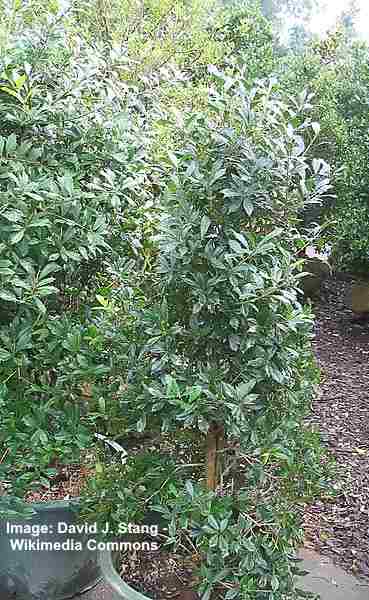
Dragon Lady hollies are excellent plants for privacy and also as border hedge
Sky Pencil Holly (Ilex crenata ‘Sky Pencil’)—The ‘Sky Pencil’ holly shrub has narrow, upright growth and shiny green leaves. This holly cultivar matures at 6 to 10 ft. (1.8 – 3 m) tall and is ideal for creating a living fence for a front or backyard.
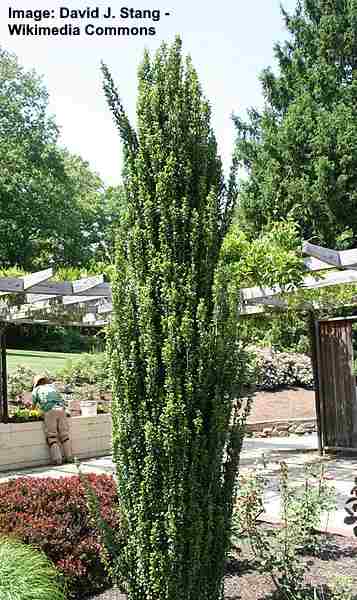
Sky Pencil Holly has narrow growth habit and is not too tall
Californian Privet (Ligustrum ovalifolium)
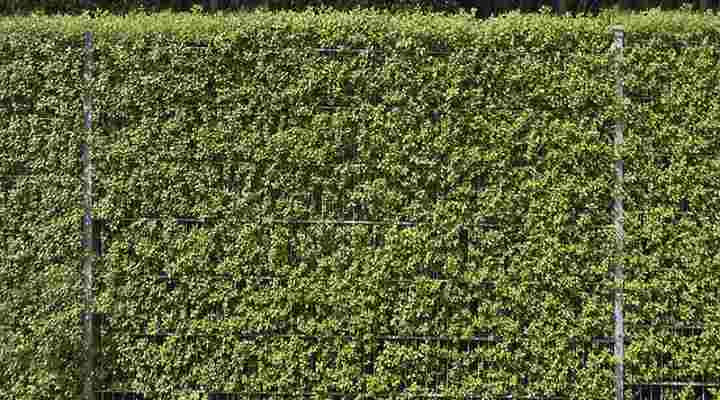
Choose privet shrubs if you want a fast growing privacy hedge or living fence
The Californian privet is a fast-growing flowering shrub that grows into a beautiful living fence. The broadleaved shrub grows between 10 and 15 ft. (3 – 4.5 m) tall and up to 15 ft. (4.5 m) wide. The dense foliage consists of dark-green, shiny ovate leaves. In summer, fragrant white flowers appear on the hedge.
Californian privet is an evergreen living hedge in USDA zones 7 to 10. In colder zones, the natural ornamental fence is deciduous and drops its leaves in the fall.
Japanese Spindle Living Fence (Euonymus japonicus)

The dense bush fence of Japanese spindle makes it excellent for privacy hedge
Also called Box-Leaf Euonymus and Evergreen Euonymus, this small evergreen shrub is an ideal hedging plant in a small-scale landscape. The Japanese spindle shrub has glossy, leathery green leaves. As a versatile plant for living fences, Japanese spindle plants perform well in full sun and heavy shade.
Some spectacular Euonymus japonicus cultivars have variegated, bright yellow and green leaves, creating a stunning colorful bushy living fence. The Japanese spindle grows up to 15 ft. (4.5 m) high and is cold hardy in USDA zones 6 through 9.
Japanese Pittosporum (Pittosporum tobira)
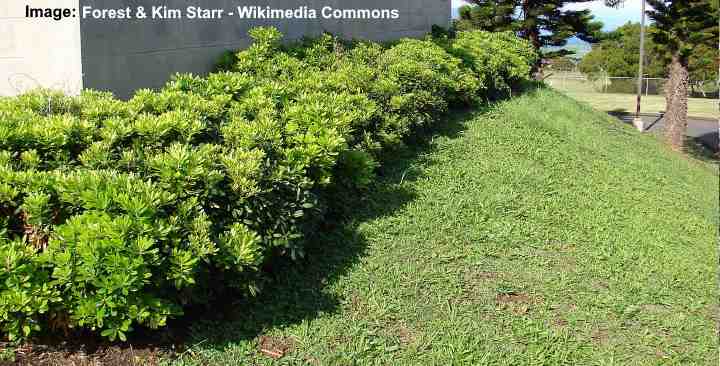
The fast growing Japanese Pittosporum is an ideal shrub for a living fence
The Japanese Pittosporum is an evergreen shrub that creates a natural privacy fence. The dense growth and compact spreading foliage grow up to 13 ft. (4 m) tall. It’s a tough, drought-resistant plant that thrives in full sun. Japanese Pittosporum plants perform best in USDA zones 8 through 10.
The Japanese Pittosporum is ideal for a flowering living screen, hedge, or barrier in warm climates.
Chinese Fringe Flower (Loropetalum chinense)
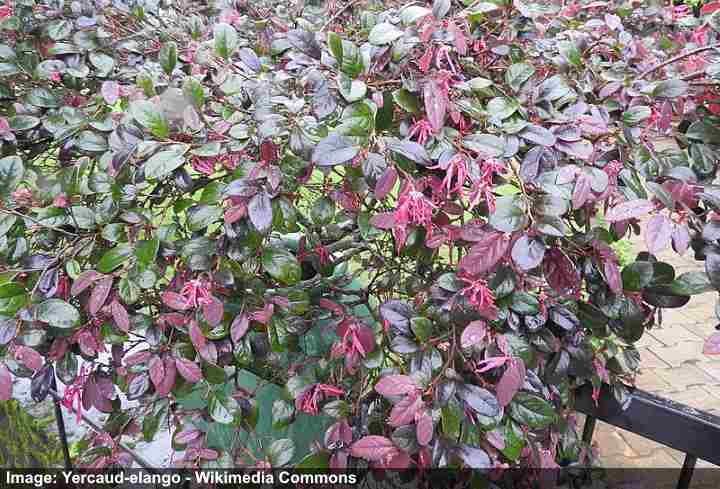
The attractive purple foliage of the Chinese fringe flower adds decorative element to your living fence
The Chinese fringe flower is an ornamental evergreen shrub that can be pruned into an attractive colorful privacy wall. The beautiful feature of this showy living fence is its spring flowers with four spindly petals. The fuzzy ovate green and purple leaves are 3” (7.5 cm) long. The bushy privacy fence plant grows between 6 and 10 ft. (1.8 – 3 m).
Grow the Chinese fringe flower to give your yard protection from the wind or as a natural privacy screen or colorful hedgerow. Suitable for growing in USDA zones 7 to 9.
Related articles:
